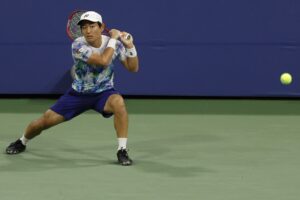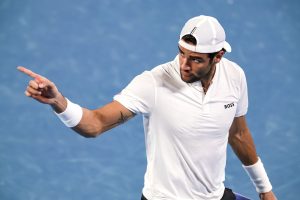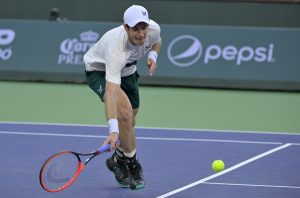Countdown to the US Open:In the second part of our series building up to the US Open, Last Word on Tennis looks back at the greatest US Open Men’s finals.
The US Open is the final Grand Slam of the year and is commonly regarded as the loudest, brashest and downright craziest of the Majors, with planes from La Guardia airport roaring overhead, fans behaving more like football (either American or Association) crowds than they do at the other Majors, and all manner of unlikely events likely to happen. As Sinatra’s theme song, New York, New York, puts it, “If you can make it there, you can make it anywhere,” but even some of the greats of the game, notably Bjorn Borg, have been unable to triumph at the US Open. Here are the five finest US Open Men’s finals, each one a five-setter and each one a genuinely historic match.
- 2012: Andy Murray beats Novak Djokovic (7–6 (12–10), 7–5, 2–6, 3–6, 6–2)
Tennis history was truly made at the US Open in September 2012 when Andy Murray became the first male British winner of a Major for 76 years. In the process, he finally proved that he was the D’Artagnan to the Three Musketeers of tennis – Roger Federer, Rafael Nadal and Novak Djokovic – and that the much-discussed “Big Four” of the men’s game was precisely that.
The groundwork for Murray’s historic win had been laid over many years, as he had first reached a Grand Slam final when he made the US Open final in 2008. On that occasion, he was swiftly despatched by Federer and he then lost two Australian Open finals to Djokovic before finally reaching the Wimbledon final in 2012, once again against Federer. Federer lost the first set but recovered to win the match, reducing Murray to tears, which finally endeared him to an All England club and crowd that had hitherto been slightly suspicious of the reserved, rather self-contained Scot.
Then came Murray’s “first” Wimbledon win. Less than a month after losing to Federer in the 2012 Wimbledon final, when most of the Centre Court Crowd were still backing the great Swiss even against a home player, Murray won through to the Olympic Men’s Singles final. In that match, he was cheered on by an unusually boisterous and patriotic Centre Court Crowd as he beat Federer in straight sets, thus denying the great Swiss the one important prize that has eluded him throughout his career, an Olympic singles gold.
The memory of that win (and of his Olympic semi-final defeat of Djokovic) seemed to sustain Murray for the rest of the summer as he surged to the final in New York. He edged the first two sets, winning the first on a tie-break and the second 7-5. He seemed set for a straightforward straight sets win, but then it was as if the full weight of British tennis history came crashing down around him as he lost the next two sets to a resurgent Djokovic. He appeared destined to suffer yet another ignominious defeat, one that would set him apart from his coach, Ivan Lendl, as the first man to lose his first five Grand Slam finals.
Embed from Getty Images
Perhaps it was the memory of that Olympic triumph, when he had defeated both Djokovic and Federer in the same weekend; perhaps it was the wise counsel of Lendl, who had finally won his first Grand Slam in Paris in 1984 when he had fought back from two sets down to beat John McEnroe; or perhaps it was just a slight easing-up or tensing-up on the part of Djokovic. Whatever it was, Murray found his form again in the fifth set and won it relatively easily (as relatively easily as one can win such a historic match) to become Britain’s first male Grand Slam champion in more than seven decades.
- 2009: Juan Martín del Potro beats Roger Federer (3–6, 7–6 (7–5), 4–6, 7–6 (7–4), 6–2)
If anyone other than Murray was ever going to rise up and challenge the hegemony of Federer, Nadal and Djokovic, it would surely have been Juan Martin del Potro, the giant Argentine whose sole Major triumph belies an enormous talent. If it hadn’t been for the series of crippling injuries that del Potro has suffered ever since his New York triumph, he would almost certainly have won more than the 2009 US Open. Nevertheless, if you are only ever going to win one Major, then you might as well win it in the astonishing style that del Potro won the 2009 US title.
Nearly a decade on from that triumph, it is worth remembering how dominant Federer and Nadal were at that point. Djokovic had yet to emerge as a genuine contender to them both, having only won the 2008 Australian Open up to that point, and between them Federer and Nadal had won every Major going back to Melbourne in January 2008. Consequently, when del Potro beat both Nadal and Federer to claim victory in New York, it was a remarkable achievement. Given that it has never been repeated at a Grand Slam since and may never be repeated again, it is legitimate to describe it as a genuinely historic feat.
First, del Potro defeated Nadal in the semi-final, virtually swatting him aside as he won in straight sets, with each set finishing 6-2. That was incredible enough, but that he followed it up by beating Federer in the final almost defied belief. Federer was going for a sixth successive US Open title, a feat that had not been achieved since Bill Tilden managed it in the 1920s. In addition, Federer, having been prevented by Nadal from winning a sixth successive Wimbledon title in 2008, was seemingly back to his best. He had finally won the French Open in 2009, when Robin Soderling surprisingly knocked out Nadal, and followed that up by winning Wimbledon, which gave him a record 15th Major win.
Federer seemed set to win the US Open as well, but del Potro was in no mood to be denied his maiden Major. His serve was like the kick of a mule, but his movement around the court (which seemed incompatible with his huge height) was like that of a ballerina. He lost the first and third sets, but won the second and fourth on tie-breaks, to set up a deciding fifth. Just as the world was waiting for Federer to reassert his total dominance over the men’s game, del Potro instead broke him early and then served out for the match and the championship.
In the process, del Potro became almost the Earnie Shavers or Ken Norton of men’s tennis in the 21st century. If Federer, Nadal and Djokovic (once he finally found his game and challenged the top two) were comparable to the great heavyweights of the 1970s – Ali, Frasier and Foreman – then del Potro was similar to one of the other great heavyweights of that period, who would have won a lot more but for injury and their unfortunate timing at competing in the greatest era of their sport.
Embed from Getty Images
- 1989: Boris Becker beats Ivan Lendl (7–6 (7–2), 1–6, 6–3, 7–6 (7–4)).
1989, the year the Berlin Wall came down, was a momentous year for Germany but for Boris Becker, Germany’s greatest ever male tennis player, it was memorable for more than that. In fact, it was his most successful year ever as a player, as it was the only one in which he won more than one Major, when he added his sole US Open triumph to his third Wimbledon title. And all this was achieved while he was still only 21, which makes it even more remarkable, especially now, when Federer and Nadal, the great veterans of men’s tennis, are still holding the next generation, or even the next two generations, of men’s players (Raonic, Dimitrov, Thiem, Zverev et al) at bay.
While the youthful Becker was achieving his career high, his opponent in the 1989 final, Ivan Lendl, was finally coming towards the end of his own extraordinary career. Lendl had first emerged more than a decade earlier as a rival to Borg, McEnroe and Connors, and when those three greats either retired (in the case of Borg), took time off the tour (in the case of McEnroe) or simply aged (in the case of Connors), he finally bestrode the tennis world like a Czech colossus. While he would never complete the career Grand Slam by winning Wimbledon (he twice lost in the final, including once to Becker), he won a total of eight Majors, including a hat-trick of US Open titles between 1985 and 1987. By the following year, however, the rot had begun to set in for Lendl, as he succumbed to Mats Wilander in five sets at the US Open final.
The 1989 US final was even better, as the young German traded sets with the veteran Czech until they reached the fifth and deciding set. That set might still be going on now if it were not for the fact that the US Open, alone among the Grand Slams, has a fifth set tie-break. The 1989 final duly went to a tie-break, the second of the match, after Becker had won the first set in similar fashion. Becker won the fifth set tie-break 7-4 to end the greatest year of his tennis career and accelerate Lendl’s descent down the world rankings and his eventual retirement.
Embed from Getty Images
- 1980: John McEnroe beats Bjorn Borg (7–6 (7–4), 6–1, 6–7 (5–7), 5–7, 6–4)
One of the many reasons why the current generation of Federer, Nadal and Djokovic are almost universally recognised as the greatest generation in the history of men’s tennis is that all three men have completed the career Grand Slam by winning all four Majors at some point. Before they did so, achieving the career Grand Slam was remarkably rare, with only Rod Laver and Andre Agassi the only other men to manage it in the Open era. Even some of the greatest male players never won all four Majors, with one particular Major proving their Achilles heel. In the case of Pete Sampras, it was the French Open, largely because his classical serve-volley style was completely unsuited to clay. In the case of Bjorn Borg, it was the US Open, although why he failed to win it remains something of a mystery.
At a time when the Australian Open was almost considered an afterthought by the world’s top players, the three other Majors held sway and Borg dominated two of them, winning Wimbledon five times between 1976 and 1980 and going one better at the French Open, which he won a remarkable six times, including four times in succession between 1978 and 1981. Given his complete mastery of both clay and grass, a feat that had not been managed by any male or female tennis player since Suzanne Lenglen in the 1920s, it was hard to fathom why he could not rule New York as he ruled Paris and London, or even win the US Open just once.
A contributing factor was undoubtedly the fact that each time he reached the US Open final he faced an American player, and not just any old American player, but two of the finest of all time, Jimmy Connors and John McEnroe, who both defeated him twice. In Europe, Borg was virtually a home favourite wherever he played, even in Paris and London, but in New York he faced openly hostile crowds that cheered on their home players vociferously.
Of those four losing finals, the closest that Borg came to winning the US Open was in 1980, when he was probably at the peak of his powers. Fresh from beating McEnroe in the Wimbledon final that was considered the greatest men’s final ever until Federer and Nadal surpassed it in 2008, Borg reached the US Open final and, facing McEnroe again, must have felt confident. McEnroe, however, was the defending US Open champion and having lost so devastatingly at Wimbledon a few months earlier he was utterly unwilling to lose to Borg again.
Over the course of five magical sets, Borg and McEnroe produced a match which, if not the equal of their Wimbledon classic, was easily one of the great US Open finals. McEnroe finally won it 6-4 in the fifth, thus breaking Borg’s stranglehold over him in the Slams and ensuring that the great Swede would never win a US Open.
Embed from Getty Images
- 1925: Bill Tilden beats Bill Johnston (4–6, 11–9, 6–3, 4–6, 6–3)
There have been many great US Open finals, including the four other finals on this list, but the award of the all-time greatest must go to the “Battle of the Bills” in 1925, between “Big” Bill Tilden and “Little” Bill Johnston, two tremendous American players who, fittingly, fought out the greatest ever men’s US Open final.
The period after World War One is crucial in the history of tennis, as it was in this period that tennis truly became an international and ultimately global sport. Indeed, it is arguable that this period was the most important in the history of tennis until the game went fully “Open” in 1968 and professionals, like the great Rod Laver, were finally readmitted to the Grand Slam events that had banned them for so long.
A hundred years ago, in the late teens and early twenties, tennis was still officially an “amateur” sport, but there were two titanic figures who effectively trained and played like professionals, and between them they catapulted tennis into the global sporting and even cultural consciousness. In Europe, there was the magisterial Suzanne Lenglen, the great French woman who ruled over Roland Garros and Wimbledon for nearly a decade, and in America there was “Big” Bill Tilden, the Pete Sampras of his day, who won an incredible six US Opens in a row between 1920 and 1925, a record that still stands to this day. Given that even the great Roger Federer was unable to equal it, let alone beat it, it may well stand forever.
In the last four of those finals, Tilden beat his great rival, Bill Johnston, who had actually won the US Open twice before Tilden’s rise to dominance, in 1915 and 1919, on the second occasion beating Tilden in the final. But once Tilden won the US Open in 1920, he proved almost impossible to beat, winning six in a row, culminating in his sixth and greatest triumph in 1925.
At the height of the Jazz Age, Big Bill and Little Bill (so named because of the difference between them in height, with Tilden over six feet tall and Johnston only five feet eight) fought out an absolute epic of a final, with every set closely contested and hard-fought. Nearly half a century before tie-breaks were invented, the second set lasted an astonishing 20 games, with Tilden eventually winning 11-9. When he then took the third set to go two sets to one up, he must have thought the match was over, especially as he had defeated the same opponent in each of the previous four finals. But Little Bill Johnston was diminutive only in stature, not fighting spirit, and he duly won the fourth set to take the match to a fifth-set decider.
Tilden eventually won the fifth set 6-3, but the match as a whole was something of a watershed for him. Quite simply, he was never as dominant on court again, in the same way that Bjorn Borg was never quite as great as he had been after winning the 1980 Wimbledon final against John McEnroe. Tilden duly surrendered his US title the following year and although he would win the US championship again in 1929 and Wimbledon in 1930 they were very much the last acts of an illustrious career. As with all the very greatest tennis matches, even though he eventually won in 1925 he had expended so much of himself in the winning that he was never quite the same player again. In that respect at least, Little Bill cut Big Bill down to size.
Enjoy articles looking back at all-time best players and tennis history in general? Make sure to check out our page devoted to stories appreciating historic achievements in tennis.






